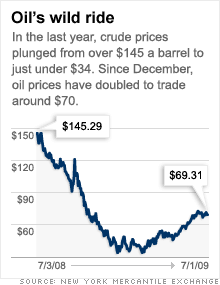Oil below $66
Oil prices fell as a stronger dollar and concerns about the U.S. economy lead to sell-off.

LONDON (Reuters) -- Oil dropped a dollar to below $66 a barrel on Friday after unemployment data hardened views economic weakness would sap energy demand and that last month's rally was overdone.
In the latest sign the economy of the world's top consumer was still struggling, data on Thursday showed U.S. employers cut 467,000 jobs in June and the jobless rate rose to a 26-year high. Euro zone unemployment climbed to a 10-year high.
"All the data was bad yesterday," said Rob Montefusco, a trader at Sucden Financial. "Technically, it looks pretty weak at the moment."
U.S. crude fell by $1.22 to $65.51 a barrel by 1718 GMT, extending the previous session's nearly 4 percent drop. London Brent crude fell $1.35 to $65.30.
Friday's trading volumes were thin as NYMEX floor trading was closed for the U.S. Independence Day holiday.
Oil prices have doubled from a low of $32.40 a barrel in December last year and they surged by 42 percent in the last quarter -- the largest quarterly gain since 1990.
But some analysts had predicted the market's rise above $70 in June could not be sustained as the economy and energy demand were still weak and oil inventories remained high.
The latest U.S. government data showed a bigger than expected increase in stocks of motor fuel ahead of the July 4 holiday weekend, typically a time of high demand as the peak of the U.S. summer driving season.
JP Morgan said in a report on Friday it expected oil prices to correct to about $60 a barrel or lower.
Technical analysts, who use past price moves to predict direction, were also taking a bearish view for the immediate term. They said the breach of the technical target of $66 added to the negative momentum on Friday.
"Risks are shifting for a downside correction toward $60 in the weeks ahead before the larger bull trend resumes," Barclays Capital technical analysts said.
For the longer term, many forecasters and analysts have said there was a risk of a supply crunch that could drive prices much higher, following under-investment in new capacity during the current period of lower oil prices and limited credit.
The Organization of the Petroleum Exporting Countries has said prices needed to be around $75 to spur investment and it has lowered its output targets by 4.2 million barrels per day since last September to try to support the market.
OPEC's higher level of discipline earlier this year surprised analysts. Earlier this year, it rose to a peak of around 80 percent of promised curbs, but as oil markets have recovered the group's compliance has faltered.
Reuters latest survey pegged discipline at 72 percent, still far above the historical average of 60 percent. ![]()

